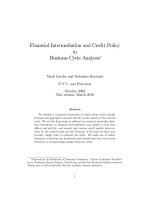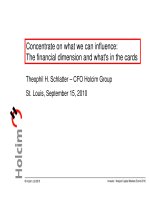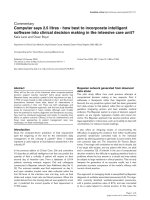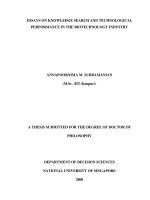Bank funding, financial instruments and decision making in the banking industry
Bạn đang xem bản rút gọn của tài liệu. Xem và tải ngay bản đầy đủ của tài liệu tại đây (5.29 MB, 297 trang )
PA LG R AV E M AC M I L L A N S T U D I E S I N
BANKING AND FINANCIAL INSTITUTIONS
S E R I E S E D I TO R : P H I L I P M O LY N E U X
Bank Funding,
Financial Instruments
and Decision-Making in
the Banking Industry
Edited by Santiago Carbó-Valverde, Pedro J. Cuadros-Solas
and Francisco Rodríguez-Fernández
Palgrave Macmillan Studies in Banking
and Financial Institutions
Series Editor
Philip Molyneux
Bangor University, UK
Aim of the Series
The Palgrave Macmillan Studies in Banking and Financial Institutions series
is international in orientation and includes studies of banking systems
in particular countries or regions as well as contemporary themes such
as Islamic Banking, Financial Exclusion, Mergers and Acquisitions, Risk
Management, and IT in Banking. The books focus on research and practice and include up to date and innovative studies that cover issues which
impact banking systems globally.
More information about this series at
/>
Santiago Carbó Valverde • Pedro Jesús Cuadros Solas •
Francisco Rodríguez Fernández
Editors
Bank Funding,
Financial Instruments
and Decision-Making
in the Banking
Industry
Editors
Santiago Carbó Valverde
Bangor University, UK
Pedro Jesús Cuadros Solas
University of Granada, Spain
Francisco Rodríguez Fernández
University of Granada, Spain
Palgrave Macmillan Studies in Banking and Financial Institutions
ISBN 978-3-319-30700-8
ISBN 978-3-319-30701-5 (eBook)
DOI 10.1007/978-3-319-30701-5
Library of Congress Control Number: 2016950067
© The Editor(s) (if applicable) and The Author(s) 2016
This work is subject to copyright. All rights are solely and exclusively licensed by the Publisher, whether
the whole or part of the material is concerned, specifically the rights of translation, reprinting, reuse of
illustrations, recitation, broadcasting, reproduction on microfilms or in any other physical way, and
transmission or information storage and retrieval, electronic adaptation, computer software, or by similar
or dissimilar methodology now known or hereafter developed.
The use of general descriptive names, registered names, trademarks, service marks, etc. in this publication
does not imply, even in the absence of a specific statement, that such names are exempt from the relevant
protective laws and regulations and therefore free for general use.
The publisher, the authors and the editors are safe to assume that the advice and information in this book
are believed to be true and accurate at the date of publication. Neither the publisher nor the authors or
the editors give a warranty, express or implied, with respect to the material contained herein or for any
errors or omissions that may have been made.
Cover image © Zoonar GmbH / Alamy Stock Photo
Printed on acid-free paper
This Palgrave Macmillan imprint is published by Springer Nature
The registered company is Springer International Publishing AG Switzerland
Acknowledgements
First and foremost we would like to thank all our contributors, whose
biographies are provided in this volume, without which this edited book
would not have been possible.
Also we want to express our gratitude to all the participants of the
2015 Wolpertinger Conference organized by the European Association
of University Teachers of Banking and Finance in September 2015 for
their insightful comments about all the papers included in this volume.
We would also like to show our gratitude to Professor Philip Molyneux
(Professor of Banking and Finance and Dean of the College of Business,
Law, Education and Social Sciences), Editor-in-Chief for the Palgrave
Macmillan Studies in Banking and Financial Institution Series, for
approving our book proposal and for his support during the process.
Also many thanks to the Palgrave Macmillan team, Aimee Dibbens
and Alexandra Morton, for their support during the publishing process.
v
Contents
1
Introduction
1
2
Does Earnings Management Affect Banks’ Cost
of Funding? An Empirical Investigation Across
an European Sample
7
Volatility Linkages and Co-movements Between
International Stocks and the Sukuk Market
31
Bank-Specific, Macroeconomic or Structural Variables:
Which Explains Bank Enterprise Lending? The Evidence
from Transition Countries
63
The Reputable Underwriting Matching in Corporate
Bond Issuances: Evidence for Non-financial Bonds
95
3
4
5
6
New Financing Instruments to Bridge the Funding
Gap: The Lesson from Italy
117
vii
viii
7
8
9
10
Contents
Microfinance Investment Vehicles: How Far Are
They from OECD Social Impact Investment Definition?
145
Intellectual Capital Disclosure and IPO Results:
Is It a Matter of Classification?
193
The Drivers of Dividend Policies in Europe
225
Long-Range Financial Decision-Making:
The Role of Episodic Prospection
253
Index
279
Notes on Contributors
Editors and ContributorsFederico Beltrame is Lecturer in Banking and
Finance at the Department of Economics and Statistics, University of Udine,
where he teaches corporate finance. He graduated in Economics at the University
of Udine and received his PhD in Business Science from the same University.
His main research interests are related to SMEs’ cost of capital, banks capital
structure, and mutual guarantee credit institutions.
Gianni Brighetti is an Associate Professor of Cognitive Psychology at the
Department of Psychology, University of Bologna, Italy. His research interests
are in the field of assessment, diagnosis and cognitive-behavioural therapy of
anxiety-related and cognitive-emotional disturbances in personality disorders,
and drug-addiction. Recently his research interests have turned also to the psychological aspects of decision-making in the field of financial investments with
reference to economic choices and savings ().
Santiago Carbó-Valverde is Professor of Economics and Finance at the Bangor
University (United Kingdom). He holds a Bsc in Economics from the University
of Valencia. He holds a PhD in Economics and an Msc in Banking and Finance
from the University of Wales, Bangor, (United Kingdom). He was Professor of
Economics at the University of Granada (Spain). He is Director of the Financial
Services Studies of Spanish Savings Banks Association (FUNCAS). He is
researcher at the Institute of Economics Research of Valencia (Ivie). He is President
of the Rating Committee of Axexor. He is an independent advisor of Cecabank.
He is President of Game Stores Iberia. He has been a collaborator and advisor of
ix
x
Notes on Contributors
the European Central Bank, the Federal Reserve Bank of Chicago, some financial
institutions such as BMN, and internationally prestigious firms. He has published
in internationally prestigious journals in economics and finance such as the
European Economic Review, the Review of Finance, the Journal of Money, Credit and
Banking, Review of Economics and Statistics, the Journal of International Money and
Finance, and the Journal of Banking and Finance. He has been a speaker in
International Conferences and Seminars at the G-20 forum, as well as in several
Central Banks Conferences.
Cristiana Cardi is a PhD Candidate in Management at Università Politecnica
delle Marche, Ancona, Italy. She teaches financial intermediation at Università
Niccolò Cusano, Rome, Italy. Her research interests involve initial public offerings and behavioral finance, with a focus on the effects of psychological biases on
investment choices.
Giusy Chesini is Associate Professor of Banking and Finance at the University
of Verona, Italy, where she specializes in the structure and regulation of international financial markets. Her main research topics include the stock exchange
industry, the evolution of financial systems, banking and risk management. She
often participates in Italian and international conferences and she has written
numerous paper and books on the above subjects.
Helen Chiappini is a Ph.D. Candidate with grant research in Management,
Banking and Commodity Sciences, curricula Banking and Finance, at Sapienza
University of Rome. She is a member of different research and consulting teams
both in national and international contexts. Her main research interests relates
to social impact investing, microfinance and measurability of social impact.
Pedro Jesús Cuadros-Solas is Lecturer in Economics and researcher in Banking
and Finance at the University of Granada (Spain). He holds a Bsc in Business
Management and Law from the University of Jaén (Spain) as well as an Msc in
Economics from the University of Granada (Spain). He is member of the
Department of Economic Theory and History at the University of Granada. He
has been visiting scholar at the Bangor Business School (Wales, United Kingdom)
and also the University of St. Andrews (Scotland, United Kingdom). His main
researches interests lie in the area of Banking and Finance, especially in corporate finance, securitization, underwriting and the role of reputation for banks,
and non-financial firms in the capital markets.
Alberto Dreassi is Associate Professor in Banking and Finance at the University
of Trieste. His main research areas include regulation and supervision of financial intermediaries, and insurance and bank accounting.
Notes on Contributors
xi
Giulia Giansiracusa studied cognitive psychology at Bologna University,
where she graduated in 2014. Her masters’ dissertation, in partnership with
Heidelberg University under the supervision of Professor Joachim Funke, investigated the relationship between perspective memory and intertemporal-choices
and the related cultural differences. Her research area focuses on mental time
traveling and decision-making ().
Elisa Giaretta is a research fellow at the University of Verona, Italy, where she
received a PhD degree. She works in the “Polo Scientifico e Didattico di Studi
sull’Impresa”, an academic center focused on the analyses of Italian enterprises.
Research topics include asset management companies, private equity, firm networks, and bank risks. She has participated in Italian and international conferences on these subjects.
Krzysztof Kil is Assistant Professor of Banking and Finance at the Cracow
University of Economics, Faculty of Finance, Poland. His research concentrates
on the issues of bank stability and bank efficiency in Central and Eastern Europe.
Mario La Torre is Full Professor in Banking and Finance at the University of
Rome “La Sapienza”. His main research areas are banking and financial innovation, ethical finance, impact finance and microfinance, audiovisual and art
financing. He is editor of the series “Studies in Impact Finance” published by
Palgrave Macmillan. His main international publications include: Microcredit
Securitization, in “Bank Stability, Sovereign Debt and Derivatives”, Social
Lending in Europe: Structures, Regulation and Pricing Models, in “Crisis, Risk and
Stability in Financial Markets”, Asset-Backed Securitization and Financial
Stability: the Downgrading Delay Effect, in “Banks Performance Risk and Firm
Financing, Banks in the Microfinance Market, in “Frontiers of Banks in a Global
Economy”. He is currently member of the taskforce on Social Impact Investments
established by the G8 countries, member of the Board of the Italian National
Body for Microcredit, and member of the Audiovisual Working Party at the
European Commission. He has been member of the Board of Directors of
Cinecittà Holding and Counsellor of the Minister of Culture. He has been
member of the consultative group for the definition of the Italian Microcredit
Law and lawmaker of the Italian Tax Credit Law for the film industry.
Caterina Lucarelli is an Associate Professor of Banking and Financial Markets
at the Department of Management, University Politecnica Marche- Italy. Her
research interests are in the fields of market microstructure and investors behaviour. Since 2007, as National Coordinator of a Research Project supported by
the Italian Ministry of University and Research, she has studied issues relating to
xii
Notes on Contributors
individual risk tolerance. As part of this work she has developed several research
streams focusing on behavior under uncertainty, moving from financial topics
(portfolio theory and risk tolerance assessments) to insurance and consumers’
behavior ().
Nicoletta Marinelli is an Assistant Professor of Banking and Financial Markets
at the Department of Economics and Law, University of Macerata,Italy. Her
main academic interests are in the area of investors’ behavior, from both the
perspectives of individual and institutional investors. Individual investors have
been studied with a specific focus on their risk tolerance assessment and the
related impact upon financial choices as well as insurance decisions. Institutional
investors have been investigated as a broad category or individually defined
types (for example, sovereign wealth funds) with a specific attention to their
effect upon firm value ().
Camilla Mazzoli is an Assistant Professor of Financial Intermediation at the
Department of Management, Università Politecnica delle Marche, Ancona,
Italy. She teaches financial intermediation, trading, and insurance. Her research
interests involve behavioral finance issues, such as financial risk tolerance and
investors’ behavior, initial public offerings, and market microstructure.
Stefano Miani is Full Professor of Banking and Insurance at the Department
of Economics and Statistics, University of Udine. Recent research topics include
pension funds and pension systems, the regulation and monitoring of insurance
companies, and the regulation of financial markets and intermediaries.
Ewa Miklaszewska is Professor in Banking and Finance at the Cracow
University of Economics, Faculty of Finance, where she chairs the Banking
Division. She is the Associate Professor of Economics at the Jagiellonian
University in Cracow, Department of Management and Public Communication.
She has held several visiting positions in foreign universities and Polish financial
regulatory institutions. Her research interests focus on bank regulation and bank
strategies.
Andrea Paltrinieri is Assistant Professor of Banking and Finance Insurance at
the Department of Economics and Statistics, University of Udine. Research
topics include, Islamic Finance, financial markets in emerging countries, asset
management and institutional investors, with a particular focus on sovereign
wealth funds.
Daniele Previtali is post-doc fellow and lecturer at Luiss Guido Carli University
(Rome, Italy). He holds a Ph.D. in banking and finance from the University of
Notes on Contributors
xiii
Rome “Tor Vergata”. In 2012 he has been visiting PhD at Stern School of
Business (New York, USA). His main research interests concern banks valuation
and banks capital structure. He also works as a consultant for a professional
studio which is involved in strategy advice for banks and other financial
intermediaries.
Francisco Rodríguez-Fernández is Professor of Economics at the University
of Granada (Spain). He holds a Bsc in Business and Economics from the
University of Granada. He holds a PhD in Economics from the University of
Granada. He is Senior Economist at the Spanish Savings Banks Foundation
(FUNCAS). He has spent time as visiting scholar at the University of Modena,
the Bangor Business School, and the Federal Reserve Bank of Chicago. He is the
consultant of several prestigious institutions namely the European Commission,
the European Research Framework Programme, the Spanish Ministry of Labour,
KPMG or Euro 6000. His research work has been published in internationally
prestigious journals in economics and finance such as the European Economic
Review, the Review of Finance, the Journal of Money, Credit and Banking, Review
of Economics and Statistics, the Journal of International Money and Finance, and
the Journal of Banking and Finance. His main research interests lie in the economics of banking, banking regulation, finance and economic growth, industrial organization, and payment instruments.
Alex Sclip is Ph.D. student in Banking and Finance at the Department of
Economics and Statistics, University of Udine. His main research topics include
insurance and asset management.
Sabrina Severini is a PhD Student in Economics at Università Politecnica delle
Marche, Ancona, Italy. She is interested in financial economics, with a particular
focus on the effects of initial public offerings on the cost of capital.
List of Figures
Fig. 3.1
Fig. 3.2
Fig. 3.3
Fig. 3.4
Fig. 4.1
Fig. 4.2
Fig. 4.3
Fig. 4.4
Fig. 4.5
Fig. 4.6
Fig. 4.7
Fig. 5.1
Fig. 5.2
Fig. 5.3
Sukuk and global index volatility
Regional index volatility
Global index dynamic correlations
Regional index dynamic correlations
The growth of bank loans to households and to
non-financial corporations in the euro area (%)
Corporate loans within total loans in CEE countries,
2004–13
Growth of loans to non-financial sector in the EU,
December 2008–March 2015
NPL for non-financial corporations in CEE, 2008–2013
Comparison of aggregate performance scores for CEE
countries
Banking market concentration in CEE-11 countries,
CR5 (%)
Bank performance of centralized and decentralized
banking markets in CEE: the MLP and the Z Scores,
2004–2014
Issuing timeline process
Average bond proceeds ($ million) by underwriters
market share for the top 15 largest underwriters by
market share during 2007–2013
Average bond proceeds ($ million) by cluster of
underwriters by market share during 2007–2013
50
52
53
54
65
68
68
69
78
88
89
101
106
107
xv
xvi
Fig. 5.4
Fig. 5.5
Fig. 7.1
Fig. 10.1a
Fig. 10.1b
Fig. 10.2
List of Figures
Average bond maturity (years) by underwriters market
share for the top 15 largest underwriters by market share
during 2007–2013
Average bond maturity (years) by cluster of underwriters
by market share during 2007–2013
Microfinance impact investment vehicles
Capitalization functions fitting to experimental choices
Capitalization functions fitting to experimental choices
Matlab interface
108
109
153
262
262
273
List of Tables
Table 2.1
Table 2.2
Table 2.3
Table 2.4
Table 2.5
Table 3.1
Table 3.2
Table 3.3
Table 3.4
Table 3.5
Table 3.6
Table 3.7
Table 4.1
Table 4.2
Table 4.3
Table 4.4
Table 4.5
Table 4.6
Table 4.7
Summary of financial information about the sample,
2005–2013
Panel data—Random effect—LLP (Regression 1)
Panel data—Fixed effects (Regression 2)
Reports sample correlations of the variables involved
in our analysis
VIF test results
Sample description
List of MSCI stock indexes in our sample
Descriptive statistics of daily price changes in sukuk
and stock indexes
Unconditional correlations between indexes
Univariate GARCH models
DCC GARCH models
Unconditional correlations between estimated variances
Dependent variables explained in the panel models
Control variables used in the models
Average Z-score level in the CEE region
MLP score (basic)
MLP (TCR) score (modified)
Comparison of the MPL and Z-scores for the aggregated
data in 2004–2014 period for CEE countries
Panel model 1a: estimations for growth of gross loans
20
21
23
26
27
40
40
41
42
46
48
49
70
71
74
76
77
78
81
xvii
xviii
Table 4.8
Table 4.9
Table 4.10
Table 4.11
Table 4.12
Table 4.13
Table 4.14
Table 5.1
Table 5.2
Table 5.3
Table 5.4
Table 6.1
Table 6.2
Table 6.3
Table 6.4
Table 6.5
Table 6.6
Table 6.7
Table 6.8
Table 6.9
Table 6.10
Table 6.11
Table 6.12
List of Tables
Panel model 1b: estimations for growth of gross loans,
with MLP score
Panel model 2a: estimations for loans to assets ratio
Panel model 2b: estimations for loans to assets ratio,
with NPLs
Panel model 3a: estimation for corporate loans to total
loans ratio
Panel model 3b: estimations for CL/TL ratio,
with MLP score
CEE-11 subgroups: countries with concentrated
and diversified banking markets
Panel model 4: market conditions and loan accessibility
in CEE: estimations for concentrated (CBG)
and diversified (DBG) group
Descriptive statistics by year
Underwriter league table by market share
in fixed-corporate bonds (2007–2013)
Univariate statistics by underwriter reputation
OLS regressions on underwriter reputation
Number of companies that meet the requirement
to issue mini-bonds in Italy (Total, SMEs, % SMEs)
in 2013
Distribution of companies in 2013 and 2014
Descriptive statistics for mini-bonds issuers
in 2013–14
Descriptive statistics for networked companies
in 2013–14
Descriptive statistics for variable analyzed
in 2013
Descriptive statistics for variable analyzed
in 2014
Student’s T test for equality in mean
OLS regression model
Variable sources and definitions
Correlation matrix for regressors in 2013
Correlation matrix for regressors in 2014
Correlation matrix for regressors in 2013–14
82
83
84
85
86
88
90
103
104
110
112
125
129
130
130
130
131
133
135
137
139
140
141
List of Tables
Table 7.1
Table 7.2
Table 7.3
Table 7.4
Table 7.5
Table 7.6
Table 7.7
Table 7.8
Table 7.9
Table 8.1
Table 8.2
Table 8.3
Table 8.4
Table 8.5
Table 8.6
Table 8.7
Table 8.8
Table 8.9
Table 8.10
Table 8.11
Table 8.12
Table 9.1
xix
OECD (2015) eligibility criteria
for social impact investing
156
Synthesis of results
170
Social target area
173
Beneficiaries
175
Good and service
177
Delivery organization
179
Measurability of social impact
182
Investor intent
184
Return expectation
186
List of control variables
200
IPOs by year
207
Descriptive statistics for single IC disclosure indexes
in the six-dimensions IC classification
208
Descriptive statistics for single IC disclosure indexes
in the three-dimensions IC classification
208
Average IC disclosure values for firms belonging to
IC intensive vs. IC non intensive sectors and according
to firm age in the six-dimensions IC
209
Average IC disclosure values for firms belonging to
IC intensive vs. IC non intensive sectors and according
to firm age in the three-dimensions IC
210
The effects of IC disclosure on the price adjustment
(PA) according to the six-dimension classification
211
The effects of IC disclosure on the price adjustment
(PA) according to the three-dimensions classification
212
Comparison of the single items included in the
dimensions: IT and processes (six-dimension classification)
and human capital (three-dimension)
214
The effects of IC disclosure on the underpricing (UP)
according to the six-dimension classification
216
The effects of IC disclosure on the underpricing (UP)
according to the three-dimensions classification
217
Comparison of the single items included into the research
and development (six-dimension classification) and relational
capital (three-dimension
218
Descriptive statistics (no. of observations, mean, median,
standard deviation, minimum and maximum) for the
companies analyzed
238
xx
List of Tables
Table 9.2
Table 9.3
Table 9.4
Table 10.1
Table 10.2
Table 10.3
Table 10.4
Table 10.5
OLS regression model with robust standard errors.
Period of analyses: 2001–14 (panel data)
Dividend policy theories and proxies
Data source and definition
Explanatory power of exponential vs. hyperbolic
discounting function
Explanatory power of exponential vs. hyperbolic
discounting function by nationality
Exponential discounting and individual features
Inability to self-project into the ‘distant’ future
Inability to self-project into the ‘distant’ future:
A comparison of Germany vs. Italy
240
244
245
265
266
267
269
270
1
Introduction
Santiago Carbó-Valverde, Pedro J. Cuadros-Solas,
and Francisco Rodríguez-Fernández
With this book, we aim to enrich the banking and finance literature,
providing insight into new research topics which are being undertaken in
the aftermath of the financial crisis. In this sense, the main purpose of the
researches included in this volume is to span all the major research fields
in finance and banking.
This book is divided into different chapters that cover a selection of
some of the most recent research studies on banking and finance. These
studies are carried out by a selection of academics from a range of prestigious European universities and research institutions. All these investigations have benefited from being discussed during the 2015 Wolpertinger
S. Carbó-Valverde
Bangor University, Bangor, UK
P.J. Cuadros-Solas (
) • F. Rodríguez-Fernández
Universidad de Granada, Granada, Spain
e-mail:
© The Author(s) 2016
S. Carbó Valverde et al. (eds.), Bank Funding, Financial
Instruments and Decision-Making in the Banking Industry, Palgrave
Macmillan Studies in Banking and Financial Institutions,
DOI 10.1007/978-3-319-30701-5_1
1
2
S. Carbó-Valverde et al.
Conference organized by the European Association of University Teachers
of Banking and Finance, held in September 2015.
Nowadays, the finance literature is specially focused on the implications of post- banking crisis developments. However, after the financial
crisis, the current research lines in banking and finance are quite broad.
In this volume we have aimed to reflect some of these lines, including
outstanding papers dealing with interesting issues. According to our
selected title the research topics covered in this volume can be structured
into different blocks:
• Bank funding
• Banks needs to finance their activity, and the cost of funding affects a
range of economic variables with important implications for both
monetary and financial stability. Several aspects of bank funding are
covered in this volume. In particular we look at how issuers are matched
with reputable underwriters in debt markets and whether earnings
management are likely to affect banks’ cost of funding. Furthermore,
bank enterprise lending is studied using bank-specific, macroeconomics and structural variables
• Financial instruments
• The greater use of financial instruments and the development of
sophisticated financial techniques during the pre-crisis period are
also covered in this volume. In this sense, together with IPOs financial instruments like sukuks and corporate bonds are studied from
different perspectives. Beside this, microfinance investment vehicles
(MIVs), listed on the market and identified as “impact investmentsoriented”, are also examined analyzing if they are compliant with
the recent definition of social impact investment suggested by
OECD.
• The relationship between new financial instruments and the importance of the funding gap is also addressed. The situation in which companies, because of market imperfections, do not get the amount of
capital that they would get in an efficient market has important implications for their financial stability.
1
Introduction
3
• Decision-Making in the Banking Industry
• Acknowledging that intertemporal people decisions are not rational
and that irrationality interferes with long-range financial decisionmaking; our study possesses an examination about the role of episodic
prospection in long-range financial decisions.
• Furthermore, the rationality behind the different characteristics of
dividend policies is also investigated using as sample data the policies of listed companies in the main European markets during the
last 15 years.
The second chapter, “Does earnings management affect banks’ cost
of funding? An empirical investigation across an European sample”, by
Federico Beltrame, Daniele Previtali and Alex Slip investigates how loan
loss provisions are used discretionally to smooth earnings, manage capital
requirements, and increase the stock market valuation. As managers’ discretionary behavior might have a negative effect, they study its impact on
the cost of funding. Their findings suggest that the discretionary usage of
provisioning affects the cost of funding, due to the increase of the overall
risk of the bank.
Chapter 3, “Volatility linkages and co-movements between international stocks and the sukuk market” by Alberto Dreassi, Stefano
Miani, Andrea Paltrinieri and Alex Sclip examines the volatility
behavior and the co-movements between sukuk and international
stock indexes. They provide evidence of lower correlations between
sukuk and US and EU stock markets as well as strong volatility linkages between sukuk and regional market indexes during financial crisis. These higher volatility linkages and dynamic correlations during
financial crises show that sukuks are hybrid instruments positioned
between bonds and equity.
In Chap. 4, “Bank-specific, macroeconomic or structural variables:
which explains bank enterprise lending? The evidence from transition
countries” by Ewa Miklaszewska and Krzysztof Kil analyze trends in
lending policies in Central and Eastern Europe (CEE). They argue in
favor of a greater importance for the macroeconomic environment, an
increasing scale, and the universal profile of banks in the structure of
banks’ loan portfolios.
4
S. Carbó-Valverde et al.
Chapter 5, “The reputable underwriting matching in corporate bond
issuances: Evidence for non-financial bonds”, by the editors Santiago
Carbó-Valverde, Pedro J. Cuadros-Solas and Francisco RodríguezFernández provides an insight into the role of the underwriter’s reputation
in debt markets, analyzing the bonds features by underwriter reputation.
We present an overview of the corporate bonds markets in Europe during
2007–2013 which argues in favour of the existence of differences in bond
terms (bond size, maturity, callability and collateralization) by underwriters’ reputation. Our findings confirm that firms and underwriters are not
randomly matched in debt markets; underwriters’ reputation plays a role
in the bond design.
In Chap. 6, “New financing instruments to bridge the funding gap:
The lesson from Italy”, by Elisa Giaretta and Giusy Chesini analyzes the
funding gap evaluating mini-bonds and companies’ networks as two
alternative funding instruments to bank debt. Using the data of Italian
companies they suggest that mini-bonds’ issuers present better financial
structures compared with networked companies to the detriment of the
cost of financing on companies’ revenues.
The next chapter, “Microfinance investment vehicles: How far are they
from OECD social impact investment definition?” by Mario La Torre
and Helen Chiappini studies Microfinance impact investments from the
OECD social impact investment definition. Applying a content analysis
they are able to demonstrate that there is still much to do in order to
“mind the gap” between MIVs management approach and the OECD
definition.
Chapter 8, “Intellectual capital disclosure and IPO results: Is it a matter of classification?” by Cristiana Cardi, Camilla Mazzoli and Sabrina
Severini, analyzes the effects produced by Intellectual Capital (IC) disclosure on the IPO results. Applying two different IC classifications they
argue that the effects of IC disclosure on the IPO results are comprehensively consistent across the different IC classifications, although some
differences emerge. This study makes clear, for listing firms, the great
benefits deriving from the proper disclosure of their non-financial assets,
to investors.
Chapter 9, “The drivers of dividend policies in Europe”, also by Giusy
Chesini and Elisa Giaretta, study which dividend policies theories drive









